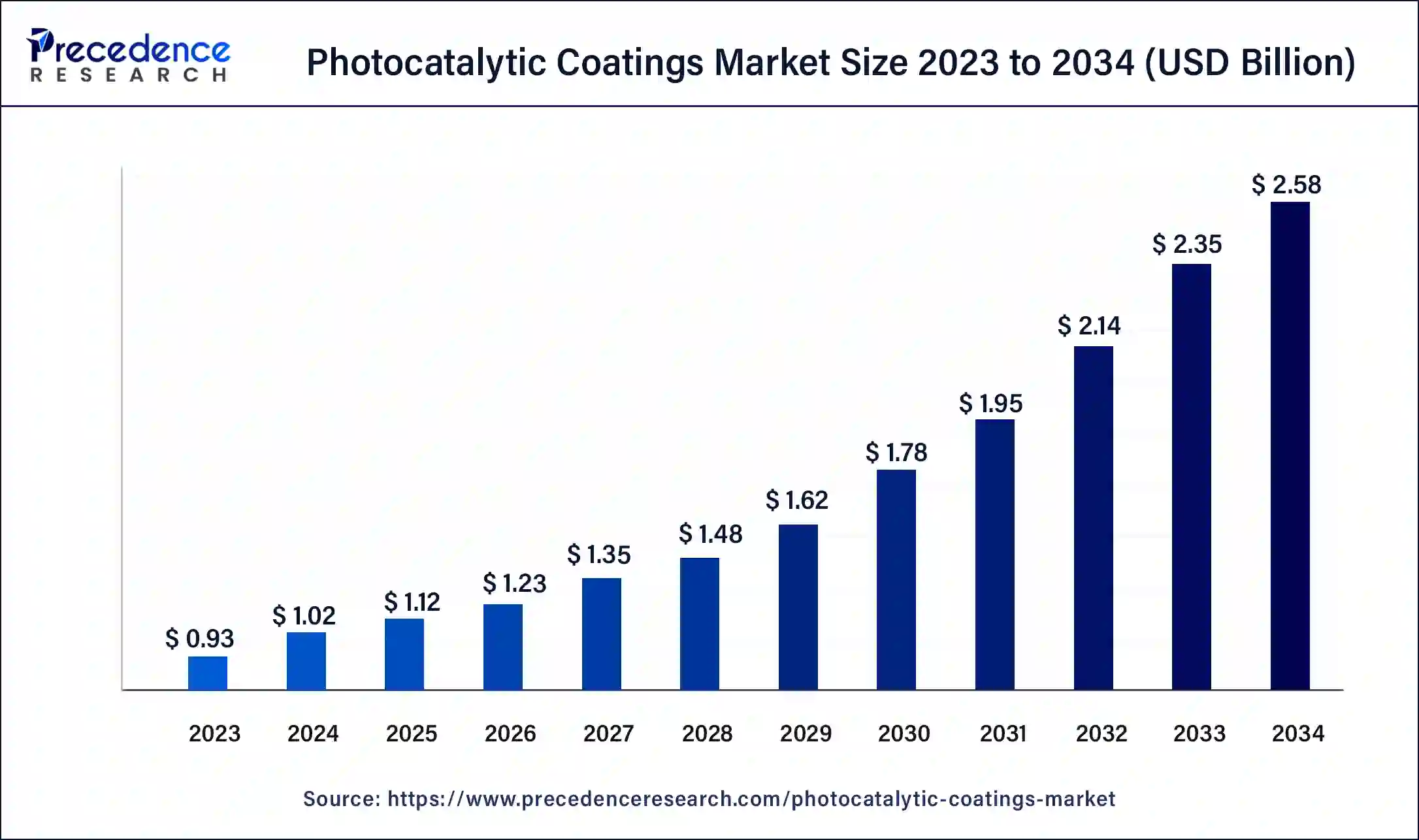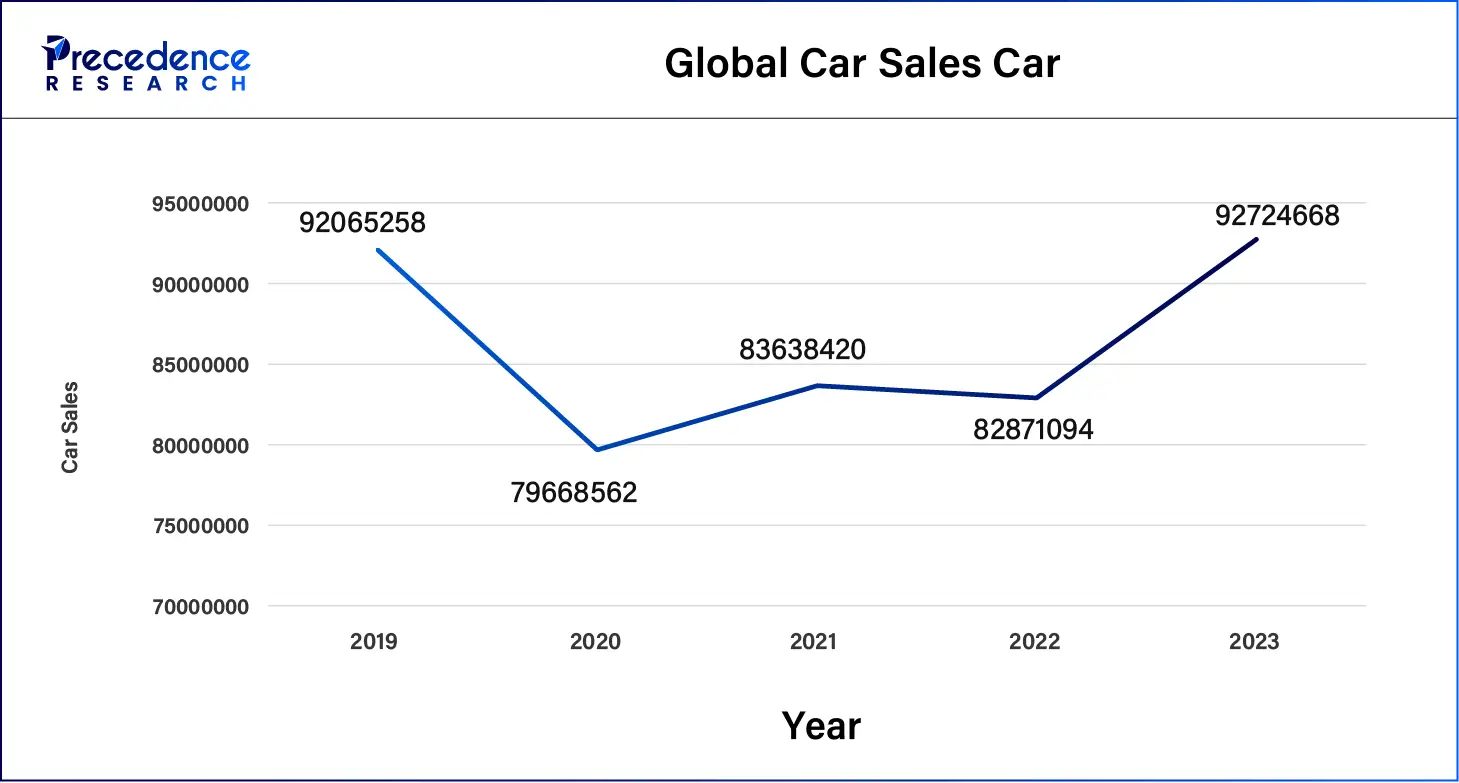January 2025
The global photocatalytic coatings market size surpassed USD 0.93 billion in 2023 and is estimated to increase from USD 1.02 billion in 2024 to approximately USD 2.58 billion by 2034. It is projected to grow at a CAGR of 9.72% from 2024 to 2034.
The global photocatalytic coatings market size is projected to be worth around USD 2.58 billion by 2034 from USD 1.02 billion in 2024, at a CAGR of 9.72% from 2024 to 2034. The photocatalytic coatings market growth is attributed to the growing demand for advanced and innovative coating solutions across various industries.

The photocatalytic coatings market has experienced rapid development due to the unique characteristics and increasing area of usage of these innovative products. These coatings are based on photocatalytic principles, which give them additional advantages such as self-cleaning, air purification, and antimicrobial properties. Market construction has been propelled by the building and construction industry and, more recently, on cost-effective, sustainable, and low-maintenance products.
Further development in photocatalytic technology and rising concerns about environment and health matters give additional strength to the market growth. Furthermore, the photocatalytic coatings market is expected to expand and develop as world industries and governments emphasize sustainability in the future.
Impact of Artificial Intelligence on the Photocatalytic Coatings Market
Machine learning algorithms allow the creation of optimal production lines that do not create unnecessary waste. AI is able to see patterns and obtain market trends in order to help a company with competition. Moreover, AI, through research and development, enhances the development of new photocatalytic coatings and, therefore, promotes new photocatalytic coating uses such as self-cleaning surfaces and air purification. In the photocatalytic coatings market, AI integration helps to increase the speed of the work performed and makes customer care efficient by providing the best solutions.
| Report Coverage | Details |
| Market Size by 2034 | USD 2.58 Billion |
| Market Size in 2024 | USD 1.02 Billion |
| Market Growth Rate from 2024 to 2034 | CAGR of 9.72% |
| Largest Market | Asia Pacific |
| Base Year | 2023 |
| Forecast Period | 2024 to 2034 |
| Segments Covered | Type, Application, End-user, and Regions |
| Regions Covered | North America, Europe, Asia-Pacific, Latin America, and Middle East & Africa |
High demand from the automotive industry
High demand from the automotive industry is expected to drive the photocatalytic coatings market. The industry desires more parts and materials that contribute to vehicle appearance and function and provide a contemporary ecological perspective. Photocatalytic coatings are functional in aspects including self-cleaning of the exterior or interiors, freshening by purging the interior of the cars, or resistance to pollutants.
The automotive industry is shifting to sustainable dimensions, which is creating a demand for these coatings. Manufacturers also consider applying these coatings to enhance the durability of exterior paint, decreasing the costs of maintenance and improving the resale value of an automobile. Moreover, the growth of the automotive industry to cater to consumer preference for vehicles that are low maintenance and friendly to the environment due to advanced coatings is expected to boost the photocatalytic coatings market in the future.

Restrain competition from alternative technologies.
Competition from alternative technologies is anticipated to restrain the market growth of photocatalytic coatings. Other sophisticated forms of coatings and surface treatment include antimicrobial coatings and hydrophobic coatings, which have similar advantages and are normally cheaper or simpler to apply. These complementing technologies give industries many choices, which hinders photocatalytic coatings from having a large market share. The presence of well-established substitutes curbs the number of photocatalytic solutions from being adopted, and this slows down the growth rate in the overall market. Furthermore, organizations are already committed to these new coating solutions, which further hinder the photocatalytic coatings market growth.
Increasing research and development investments
Increasing research and development investments are anticipated to offer immense opportunities for players competing in the photocatalytic coatings market. Industrial firms concentrate on improving the performance, stability, and versatility of these coatings for application in a wide variety of fields. These new coating solutions offer the desired functionality irrespective of the condition around the coated structure, such as lack of light at night or very low temperatures.
These innovative technologies enhance the efficacy of current products that have photocatalytic coatings and open up new areas of use, improving growth in other unexplored markets. Furthermore, R&D to lower the costs of production makes these sophisticated surface coatings more readily marketable, which further propels the market in the coming years.
The titanium dioxide segment held a dominant presence in the photocatalytic coatings market in 2023 due to their better photocatalytic properties and wide useability in various industries. Being very efficient at degrading organic contaminants and offering self-cleaning surfaces, it was a favored material by manufacturers in the construction, automotive, and consumer goods industries. Titanium dioxide did not change color or decompose when exposed to ultraviolet (UV) light, which is relied upon to make structures visible and readable in daylight and at nighttime. Additionally, increasing the awareness of green building materials coupled with the increasing worry about the quality of air we breathe further boosts the use of titanium dioxide-containing coatings.
The zinc oxide segment is expected to grow at the fastest rate in the photocatalytic coatings market during the forecast period of 2024 to 2034, owing to the growing use of UV-protection and antibacterial coatings. Sectors, such as health care, consumer products, and food packaging, are focusing on safety that propels the uptake of zinc oxide-based photocatalytic coatings. Zinc oxide has the ability to cover dangerous UV radiation, and it is, at the same time, an antimicrobial material, which is very important in coating situations where hygiene is important. Furthermore, the heightened consumer awareness about the need for UV protection and antibacterial coatings will further boost the segment in the coming years.
The self-cleaning segment accounted for a considerable share of the photocatalytic coatings market in 2023 due to their efficiency and the possibility of saving money regarding cleaning costs. These coatings employ the photocatalytic effect to break down organic soiling and staining, and exposure to light reduces this type of soiling without requiring manual intervention.
The advancement of self-cleaning coatings mostly resulted from the upsurge in demand for building and construction structures that require an end product that is easy to maintain and durable. Furthermore, they are prominently installed in heavily trafficked premises, including governmental and commercial facilities, transportation centers, and the appreciation of the global population rate for intelligence, thus boosting the market.
The air purification segment is anticipated to grow with the highest CAGR in the photocatalytic coatings market during the studied years, owing to the increasing awareness about the cleanliness of air and environmental issues. Photocatalytic coatings are helpful for the breakdown of pollutants, such as volatile organic compounds (VOCs) and nitrogen oxides (NOx), and thus, they are valued in urbanized and industrial areas.
Advancements in the quality of indoor air and increased stringency in environmental conservation laws are two factors that are most likely to drive increased demand for air purification coatings. Due to their ability to enhance clean air supply while minimizing emissions of hazardous substances, they are suitable for residential, commercial, and industrial uses. Moreover, the increment towards the incorporation of air purification coatings is the rise in smart buildings and sustainable structures, which will further fuel the segment in the coming years.
The building & construction segment led the global photocatalytic coatings market due to its rising need for environmentally friendly, low-maintenance construction materials. The application of photocatalytic coatings offers anti-fouling properties, fresh air, and a longer useful life of the outer facing of construction. The growing focus on green building practices and energy-efficient designs makes architects and builders use this coating for newly built and retrofitted buildings for residential and commercial uses. Photocatalytic coatings assist in cutting costs of maintenance of facades and contribute to the enhancement of aesthetic and environmental aspects of the buildings. Moreover, the rapid growth of urban structures and increasing demand for environmental protection boost the demand for photocatalytic coatings in the building and construction industries, thereby boosting the market.
The healthcare segment is projected to expand rapidly in the photocatalytic coatings market in the coming years, owing to the new awareness regarding hygiene, infection control, and better medical facilities. The photocatalytic coatings are useful in areas such as hospitals, clinics, and laboratories, as they are self-cleaning and provide help to control and prevent the distribution and growth of bacteria. Increasing infection consciousness and the need for healthcare organizations to have facilities the demand for these types of coatings.
The effectiveness of these compounds in degrading toxic and destructive microbial activities makes them very good to be used in hospitals where issues with cleanliness are very crucial. Additionally, the increasing research and development of new generations of healthcare equipment and products and the rising importance of infection prevention are expected to support the photocatalytic coatings market in the healthcare segment.
Asia Pacific led the photocatalytic coatings market in 2023, owing to urbanization, industrialization, and increasing concern about environmental problems. China, Japan, India, and various other countries have high demands for developing building materials, including photocatalytic coatings, to reduce pollution and preserve the aesthetic looks of buildings. Furthermore, the growth and endorsement of green building envelopes and sustainable construction practices by governments across the globe further boost the demand for these coatings solutions.
North America is observed to grow at the fastest pace in the photocatalytic coatings market during the forecast period due to the tightening of environmental legislation and rising consciousness in the community for environmental concern and technology innovation. The United States of America and Canada show high interest in green building materials and innovation that reduces IAQ and energy consumption.
Due to increased adaptability to green building certifications, including LEED and BREEAM, photocatalytic coatings are promoted in construction and renovation at the regional level. Furthermore, the growing consciousness of environmental effects arising from industries fosters the use of these coatings in numerous applications in this region.
| States | LEED-Certified Residential Units |
| California | 39296 |
| Texas | 24598 |
| New York | 24598 |
| Washington | 10521 |
| Colorado | 8091 |
Segments Covered in the Report
By Type
By Application
By End-user
By Geography
For inquiries regarding discounts, bulk purchases, or customization requests, please contact us at sales@precedenceresearch.com
No cookie-cutter, only authentic analysis – take the 1st step to become a Precedence Research client
January 2025
February 2025
January 2025
January 2025